On Day 2 of our ATTC Calgary with Truck Gallery’s CAMPER Urban Discovery project, our ongoing work finds us asking questions about a city that we’re still just getting to know.
The questions are, necessarily, basic and straight forward. We’re not conducting deep sociological or statistical research, but rather trying to tease out a series of narratives that we know we haven’t yet heard about this place. Over the course of the residency, we’re aiming to develop a practice, a series of tactics that aim to unfold a way to get to know a place and the things that go about shaping the things we can know about a place. Cities are continually enacted through the narratives that we hear, create, and tear apart through daily practice, and we’re interested in both the narratives and that daily practice.
Over the course of a few hours on Thursday afternoon, we hear about many parts of the city that are worth loving, and worth changing. Somehow, an impression is made upon us that aligns with what we felt during our algorithmic walk — that is, Calgary is a city that isn’t readily touchable. It feels distant even when it’s right in front of you, and somehow the things we heard about the city from lifelong residents and people on holiday were the things that are legible from a distance, but in some instances, distanced from lived experience.
Ahead of Thursday’s event, Wednesday night found us heading into CJSW for an interview on their Artslink show. The campus itself is away from downtown Calgary, separated by the Bow River. Josh described the campus as somewhat inspiring, it’s one place in the city that perhaps uses its expansiveness to some sort of advantage. The surrounding area feels much like SW Ontario, really spread out.
Inside the station, we get a sense of CJSW’s history.
Inside an office, a poster from Broken City, the venue out here in Calgary.
While we await our interview, Josh flips through hundreds of CDs.
And then, on-air.
Afterwards, we head out and Michelle spots Rabbits on campus.
And walking over three lanes of traffic, we wait for the C-Train back home.
Thursday afternoon arrives quickly and we prepare the tools for the day: lots of stickies and markers.
Alongside a pile of colours.
The CAMPER will serve as our studio lab over the next week and we anticipate on making use out of the vehicle itself. An old CAMPER is a good conversation start in and of itself, but we thought we should also make a sign.
Along with a banner sign, we drop three rolls of paper over the side of the CAMPER to act as a background for our stickies. Above, Michelle lowers one of the rolls of paper.
Josh, Justin, and Todd working on the sign.
From on top of the camper, we setup our sign, asking passersby to tell us about Calgary.
And the questions we ask go something like this: “What do you love about Calgary?”, “What would you change about Calgary?”, and eventually, “What do you hope for Calgary?” They’re familiar questions, but useful — nuances come out in conversations, while the directness of what we asked provides a place of polarization from which to start those conversations. If you can set the boundaries of an idea, you create a useful space in between to actually tease out something novel.
All of our activity in setting up the CAMPER immediately gets some curious passersby asking us questions, which in turn, gives us a great opportunity to ask questions as well.
Using stickies to take quick notes from our interviews and we immediately begin to get a range of responses.
Vanessa Annand from Avenue Calgary stops by to ask us some questions as well.
We hear about the ways in which people would want to change the aesthetic experience of the city from the freeways leading into its core.
We also hear about a nostalgia for a city from years ago.
And our notes try to document the essence of each conversation.
We adhere the stickies at random to the rolls of paper creating a mass of responses.
At times, there’s a lot of conversation to get to one thing they love or want to change about the city.
At other times, it’s a quick comment.
More interesting than any summary written onto a sticky is the story that gets told to back up or frame the short statement. Details are revealed about one’s history with this place and the nuances are incredible.
From above, Josh being documented documenting Justin interviewing a Calgarian.
The good parts of Calgary are what anyone would hope to hear about their city.
Art galleries, the climate, the downtown, a youthful and entrepreneurial community.
The things asking to be changed all feel large and looming and impenetrable by everyday community members. It feels like the city itself is untouchable by many people who add to our list.
But the things noted as needing change are worthy of a lot of imagination, things like moving the stampede to Edmonton.
And the good things spark our imagination for things back home.
Todd and Josh interviewing.
More conversations.
And, then we begin to talk about the middle — the hope for a place.
We hear more about immigrant’s first experiences in the city and people start taking it upon themselves to add notes of hope.
Interviews in Calgary.
The CAMPER near the end of the afternoon as things quiet down.
Some more samples of things that people don’t like about Calgary.
Some directly experienced, some politically charged.
Some that shape an aesthetic experience of a place.
And others that start to draw a narrative of the incredible explosion of wealth in Calgary.
Others that trace a very inside understanding of this place.
And others that note deeper issues.
And the common complaints.
And a cluster of ideas that are likely very interrelated.
Hope provides a vision of Calgary that stretches through arts, culture, and the social well-being of a place.
We likely could do an entire afternoon on the hope for Calgary, and perhaps we will… there’s much to understand about a city through the narratives of hope we tell ourselves about it.
The things people love about Calgary, some are more sarcastic than others.
And things that genuinely seem to be based on very intimate experiences of the city.
Things to love based on the history.
And the economic and social realities.
And things to love that seem to fly in the face of things that need changing.
And notes on the intersections of interests that bring a city to life through experience and activity.
A view of all the notes collected.
And Todd adds one final sticky to the roll.
The last note. We plan to build a database of sorts around these responses, though not to draw any specific conclusions. We hope to gather the strands of narratives that go into building a larger experience of place to assist us in looking at the distance between the lived experience and the experience we’re told about as visitors (or as citizens). That distance and a developing a practice to explore that distance is what we’re hoping to work towards over the coming days.
Huge thanks to Todd from TRUCK for helping us ask questions and document.
Late in the afternoon, we tear down at our CAMPER location and head out with Randy to get supplies for the coming day’s activities.
We’re planning to do an imaginative temporal mapping of the timelines of the city.
We decide to create a modular chalkboard, something that can be easily affixed to the side of CAMPER.
We pick up some masonite hardwood and chalk paint.
Back at home base, our selection of materials.
And, what we’re hoping is going to be a decent quality chalkboard paint.
Oh, and stencils.
On the balcony, we do a coat of primer on the 15 sheets of masonite.
Quick-dry primer makes the task a lot easier as we can only fit about 8 sheets on the balcony at a time.
Shortly after, we can start a coat of the chalkboard paint.
Josh at work.
This small can let us do 3 coats on 15 sheets.
Coat #1 drying.
And then moved inside to finish drying…
…while Michelle starts on the second pile.
Finishing up the can of chalkboard paint.
A final coat.
And then drying over night … we’re uncertain if we’ll use these on Friday or Saturday, the weather report isn’t looking good for this afternoon.
We’re currently compiling and tagging the data we collected during our Exploring/Exploding Calgary event on Thursday afternoon and planning the next round of activities. More tomorrow. If you’re in town today, and don’t mind the rain, stop by, we’ll be on site from 3pm-6pm.
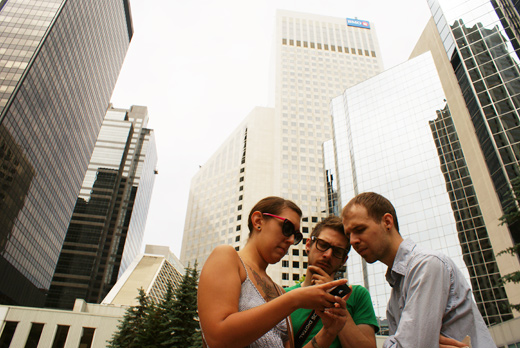










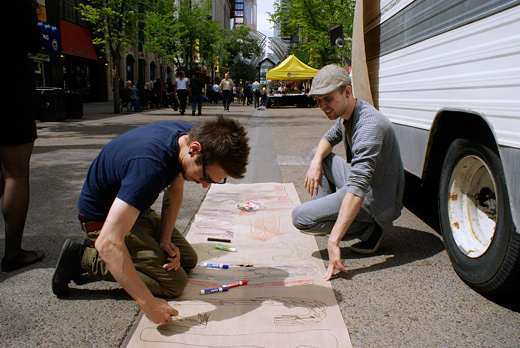
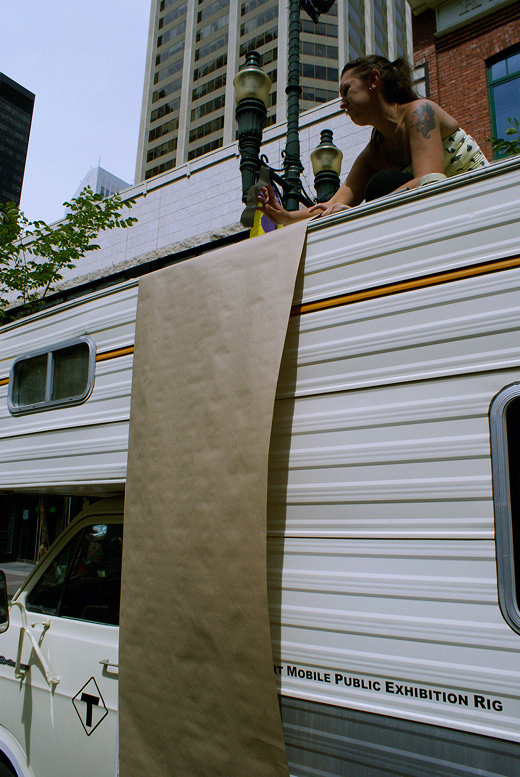

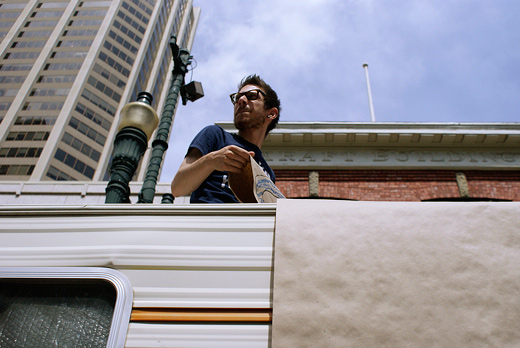


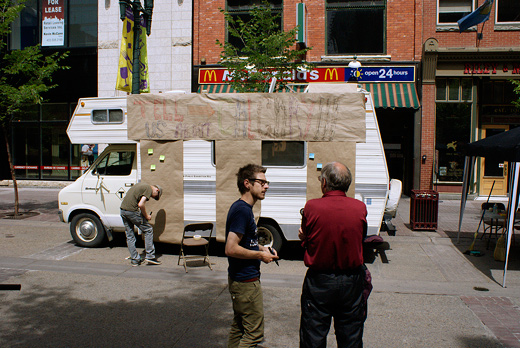
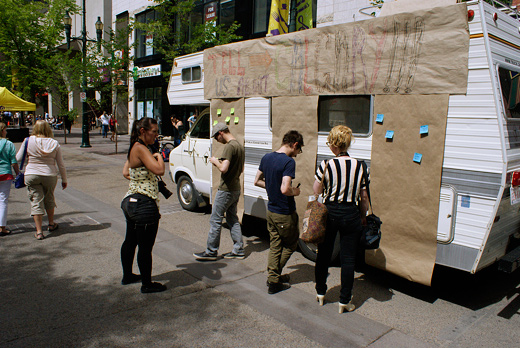
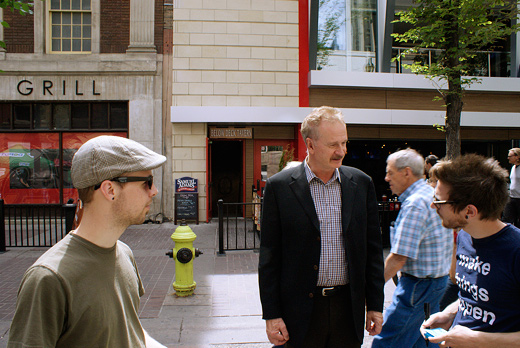
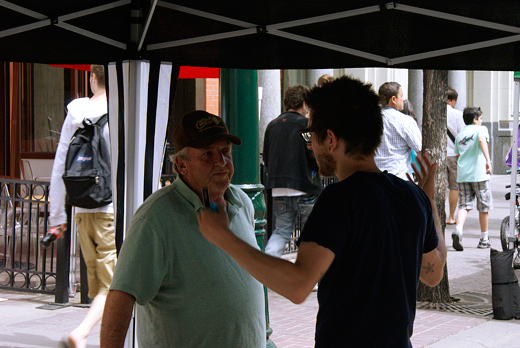
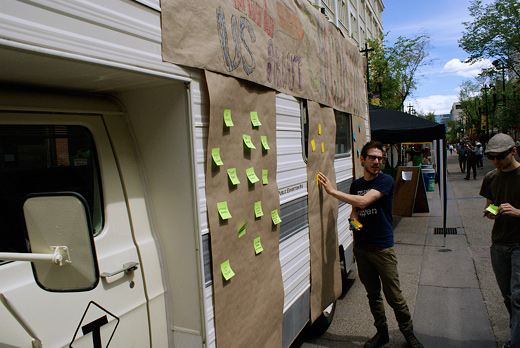
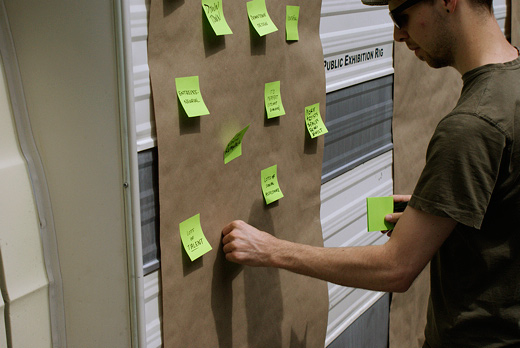
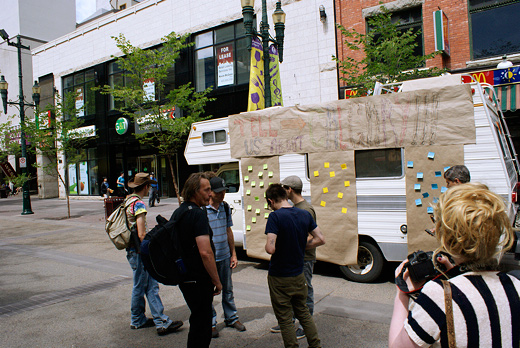
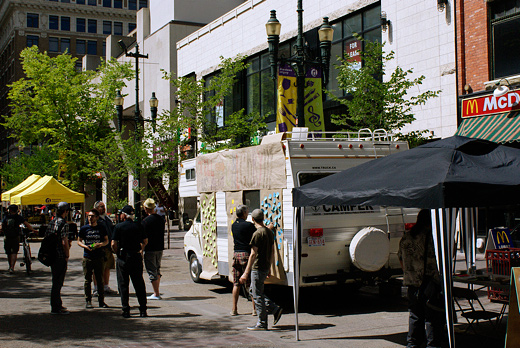
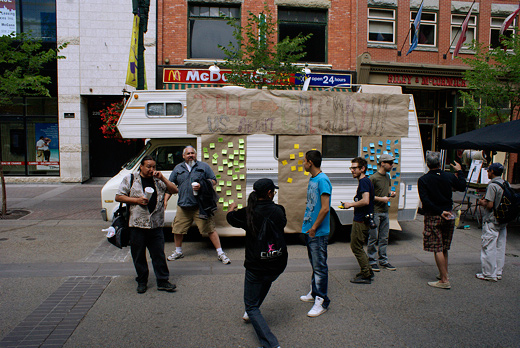
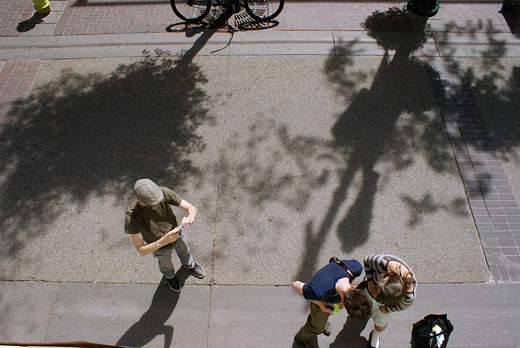

































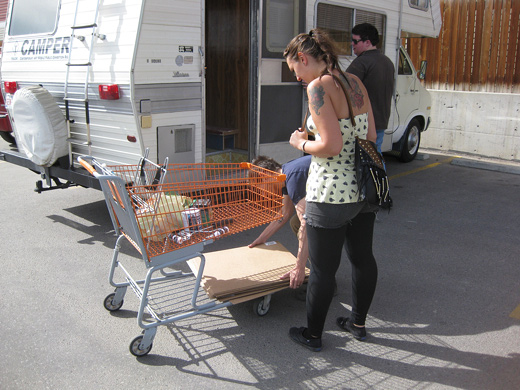














ATTC Calgary Day 2: Stories of a Distanced City http://t.co/h4eYXkO
Guys, this looks awesome! Can’t wait to hear about it from you when you come back.
Thanks Sara! We have much to share with you guys. Take care.